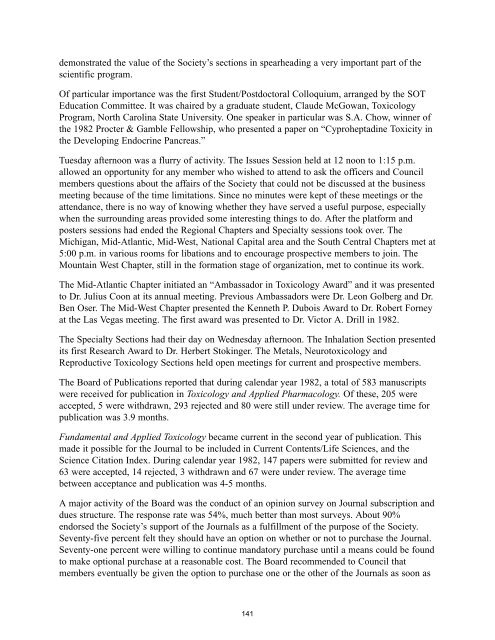SOCIETY O. TOXICOLOGY HISTORY - Society of Toxicology
SOCIETY O. TOXICOLOGY HISTORY - Society of Toxicology
SOCIETY O. TOXICOLOGY HISTORY - Society of Toxicology
You also want an ePaper? Increase the reach of your titles
YUMPU automatically turns print PDFs into web optimized ePapers that Google loves.
demonstrated the value <strong>of</strong> the <strong>Society</strong>’s sections in spearheading a very important part <strong>of</strong> the<br />
scientific program.<br />
Of particular importance was the first Student/Postdoctoral Colloquium, arranged by the SOT<br />
Education Committee. It was chaired by a graduate student, Claude McGowan, <strong>Toxicology</strong><br />
Program, North Carolina State University. One speaker in particular was S.A. Chow, winner <strong>of</strong><br />
the 1982 Procter & Gamble Fellowship, who presented a paper on “Cyproheptadine Toxicity in<br />
the Developing Endocrine Pancreas.”<br />
Tuesday afternoon was a flurry <strong>of</strong> activity. The Issues Session held at 12 noon to 1:15 p.m.<br />
allowed an opportunity for any member who wished to attend to ask the <strong>of</strong>ficers and Council<br />
members questions about the affairs <strong>of</strong> the <strong>Society</strong> that could not be discussed at the business<br />
meeting because <strong>of</strong> the time limitations. Since no minutes were kept <strong>of</strong> these meetings or the<br />
attendance, there is no way <strong>of</strong> knowing whether they have served a useful purpose, especially<br />
when the surrounding areas provided some interesting things to do. After the platform and<br />
posters sessions had ended the Regional Chapters and Specialty sessions took over. The<br />
Michigan, Mid-Atlantic, Mid-West, National Capital area and the South Central Chapters met at<br />
5:00 p.m. in various rooms for libations and to encourage prospective members to join. The<br />
Mountain West Chapter, still in the formation stage <strong>of</strong> organization, met to continue its work.<br />
The Mid-Atlantic Chapter initiated an “Ambassador in <strong>Toxicology</strong> Award” and it was presented<br />
to Dr. Julius Coon at its annual meeting. Previous Ambassadors were Dr. Leon Golberg and Dr.<br />
Ben Oser. The Mid-West Chapter presented the Kenneth P. Dubois Award to Dr. Robert Forney<br />
at the Las Vegas meeting. The first award was presented to Dr. Victor A. Drill in 1982.<br />
The Specialty Sections had their day on Wednesday afternoon. The Inhalation Section presented<br />
its first Research Award to Dr. Herbert Stokinger. The Metals, Neurotoxicology and<br />
Reproductive <strong>Toxicology</strong> Sections held open meetings for current and prospective members.<br />
The Board <strong>of</strong> Publications reported that during calendar year 1982, a total <strong>of</strong> 583 manuscripts<br />
were received for publication in <strong>Toxicology</strong> and Applied Pharmacology. Of these, 205 were<br />
accepted, 5 were withdrawn, 293 rejected and 80 were still under review. The average time for<br />
publication was 3.9 months.<br />
Fundamental and Applied <strong>Toxicology</strong> became current in the second year <strong>of</strong> publication. This<br />
made it possible for the Journal to be included in Current Contents/Life Sciences, and the<br />
Science Citation Index. During calendar year 1982, 147 papers were submitted for review and<br />
63 were accepted, 14 rejected, 3 withdrawn and 67 were under review. The average time<br />
between acceptance and publication was 4-5 months.<br />
A major activity <strong>of</strong> the Board was the conduct <strong>of</strong> an opinion survey on Journal subscription and<br />
dues structure. The response rate was 54%, much better than most surveys. About 90%<br />
endorsed the <strong>Society</strong>’s support <strong>of</strong> the Journals as a fulfillment <strong>of</strong> the purpose <strong>of</strong> the <strong>Society</strong>.<br />
Seventy-five percent felt they should have an option on whether or not to purchase the Journal.<br />
Seventy-one percent were willing to continue mandatory purchase until a means could be found<br />
to make optional purchase at a reasonable cost. The Board recommended to Council that<br />
members eventually be given the option to purchase one or the other <strong>of</strong> the Journals as soon as<br />
141
















